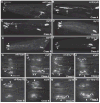Identification of genes involved in the ciliary trafficking of C. elegans PKD-2
- PMID: 18407554
- PMCID: PMC3118579
- DOI: 10.1002/dvdy.21531
Identification of genes involved in the ciliary trafficking of C. elegans PKD-2
Abstract
Ciliary membrane proteins are important extracellular sensors, and defects in their localization may have profound developmental and physiological consequences. To determine how sensory receptors localize to cilia, we performed a forward genetic screen and identified 11 mutants with defects in the ciliary localization (cil) of C. elegans PKD-2, a transient receptor potential polycystin (TRPP) channel. Class A cil mutants exhibit defects in PKD-2::GFP somatodendritic localization while Class B cil mutants abnormally accumulate PKD-2::GFP in cilia. Further characterization reveals that some genes mutated in cil mutants act in a tissue-specific manner while others are likely to play more general roles in such processes as intraflagellar transport (IFT). To this end, we identified a Class B mutation that disrupts the function of the cytoplasmic dynein light intermediate chain gene xbx-1. Identification of the remaining mutations will reveal novel molecular pathways required for ciliary receptor localization and provide further insight into mechanisms of ciliary signaling.
Copyright (c) 2008 Wiley-Liss, Inc.
Figures



References
-
- Anderson P. Mutagenesis. Methods Cell Biol. 1995;48:31–58. - PubMed
-
- Bae YK, Qin H, Knobel KM, Hu J, Rosenbaum JL, Barr MM. General and cell-type specific mechanisms target TRPP2/PKD-2 to cilia. Development. 2006;133:3859–3870. - PubMed
-
- Bargmann CI. Comparative chemosensation from receptors to ecology. Nature. 2006;444:295–301. - PubMed
-
- Barr MM, DeModena J, Braun D, Nguyen CQ, Hall DH, Sternberg PW. The Caenorhabditis elegans autosomal dominant polycystic kidney disease gene homologs lov-1 and pkd-2 act in the same pathway. Curr Biol. 2001;11:1341–1346. - PubMed
-
- Barr MM, Sternberg PW. A polycystic kidney-disease gene homologue required for male mating behaviour in C. elegans. Nature. 1999;401:386–389. - PubMed
Publication types
MeSH terms
Substances
Grants and funding
LinkOut - more resources
Full Text Sources
Other Literature Sources
Miscellaneous

